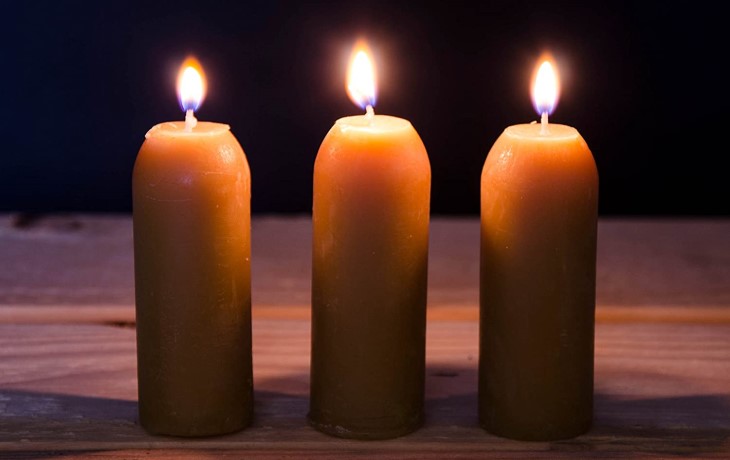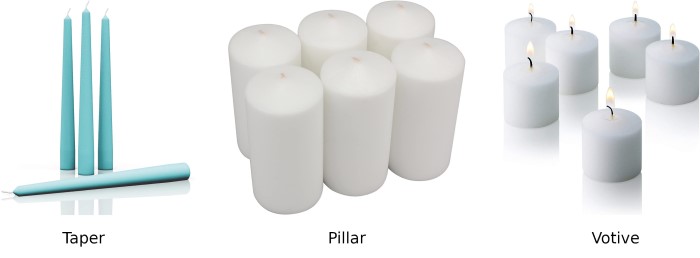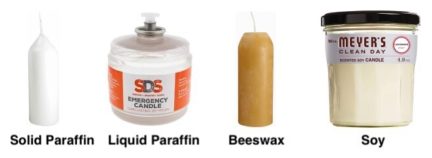Candles used to be a must-have for any beginner prepper up until just a few years ago. But modern LED, rechargeable battery, and solar charger tech have changed the equation — making candles more of a nice-to-have backup, for very long-term emergencies where it makes sense to have unpowered passive light, or for a fringe event like an EMP attack.
In practice, most people end up with a few day’s (or more) worth of candles in their home supplies, and possibly a candle or three in their away-from-home kits.
Survival candles can also help with needs other than simply lighting an area:
- A few candles in something like a terracotta pot can create enough warmth to prevent hypothermia.
- Warming food.
- Candles can be a good way to hold a flame instead of burning through multiple matches, fire tinder, or other fuel you want to conserve, or the candle can help dry out damp material before igniting it.
- Fat-based candles (namely tallow candles) can be eaten if you’re desperate.
- The low, steady heat can be great for improvising or repairing gear, such as a split plastic seam in a tent.
- Beeswax candles can treat leather or make improvised tools rust-proof.
- There’s something to be said about the mental health benefit in a long-term emergency of having candles around — even if it’s just to take a break from your headlamp.
- Mirrors behind a candle not only help magnify the light spread in a room, but you can use them to signal/communicate far away.
- Unlike in the movies, you wouldn’t sterilize medical equipment directly over a flame. But maybe you can get water hot enough to boil and sanitize that way.
Have you ever stopped to think about how candles work? In a traditional wax candle, the wick is lit, which melts the wax, which is then wicked / absorbed and acts as fuel for the fire.
Candles don’t necessarily have to be made of wax, either. Traditionally they were made of animal tallow, but candles can also be made from liquids like olive oil. Candles can be made all sorts of ways, but fundamentally they consist of a wick and some sort of slow-burning fuel.
The most important stuff:
- Most emergency candles are meant to last between 20-115 hours.
- Candles melt around 140-180 F (60-82 C), which means they probably won’t store well in your car trunk or other hot areas. We’ve even lost candles to a hot attic.
- If stored properly, candles otherwise last forever. Scented candles can lose their scent over time, but that’s not our concern here.
- For house candles, liquid paraffin is good because they are sealed, don’t drip, burn clean, and last for over 100 hours.
- Solid paraffin wax is common but less ideal because it burns dirty.
- For go-bags etc, choose self-contained candles in metal tins or something similar.
- Avoid glass containers because the glass isn’t worth the extra weight when on foot and broken glass + darkness = bad news.
- Prefer candles that are freestanding / don’t depend on other pieces for a foundation. Some models are designed to work within separate lanterns, for example.
- Avoid models built in a way that the melted wax can drip outside of the container.
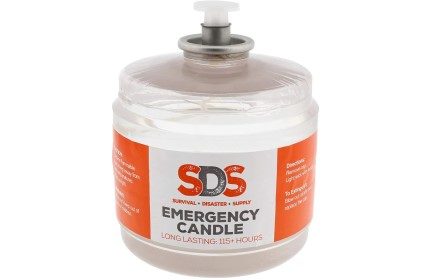
Best for most:
SDS Liquid Oil Candle
This style of candle, where a large amount of liquid paraffin is kept in a plastic container, are typically the best form factor for home supplies. We’ve tossed models like this around for years and rarely have problems with leaks. This SDS model will last around 115 hours — if you burn it for 6 hours a day, that’s enough to cover your basic two weeks of preparedness.
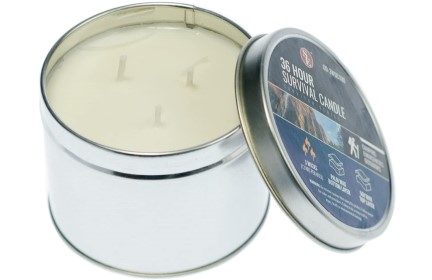
Long lasting:
SE Survivor Series 36-Hour Emergency Candle
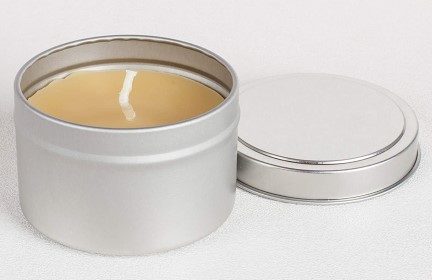
Natural beeswax:
Candle Buzz Travel Tin
When storing candles in away-from-home kits, it’s nice to use this metal tin style because it’s durable, the wax is contained, you can use the lid to quickly put out the flame and toss it back in your bag, it offers some wind protection, etc. The SE Survivor candle tin has three wicks which you can burn one at a time for longer burn time, or light all three for more light and heat. The Candle Buzz beeswax tin is a nice option if you want something on the natural side, and beeswax has a number of uses in the field like sealing leather and rust-proofing metal.
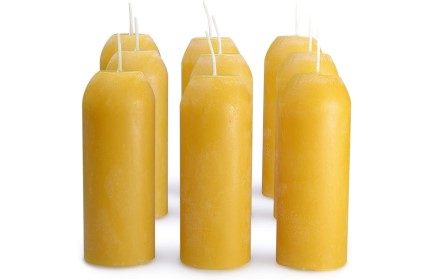
Natural candles:
UCO 12-Hour Natural Beeswax Candles
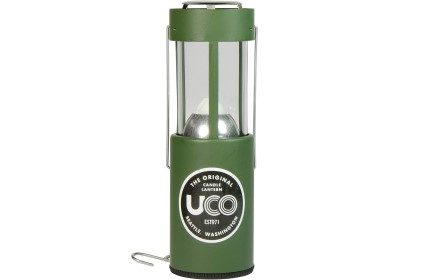
Lantern accessory:
UCO Candle Lantern
If you prefer a more natural option, the UCO beeswax candles are a good go-to, but only last 12 hours each. UCO candles can be placed on a tray or used in the UCO Candle Lantern.
Contenders
Although not currently top picks, these are decent options:
- Bluecorn Beeswax 100% Raw Beeswax Pillar
- Coghlan’s Candles, 5 Pack
- Coghlan’s Tub Candles
- Coghlans Emergency Candles — 2-pack with Metal Holders
- Coghlan’s 36-Hour Survival Candle
- Colonial Concepts 100-Hour Candle
- Exotac CandleTin
- Yartzeit 9-Day Candle – 2-pack Kosher Yahrtzeit Memorial and Yom Kippur Candle
Be prepared. Don’t be a victim.
Want more great content and giveaways? Sign up for The Prepared’s free newsletter and get the best prepping content straight to your inbox. 1-2 emails a month, 0% spam.
How many candles should you have?
In the article “Emergency Lighting” in the LDS Preparedness Manual, authors Robert Roskind and Greg Pope say, “Every family should have a large supply of candles. Three hundred sixty-five candles, or one per day is not too many. The larger the better.”
365 candles isn’t a crazy amount, but that also may be too overwhelming for a casual prepper.
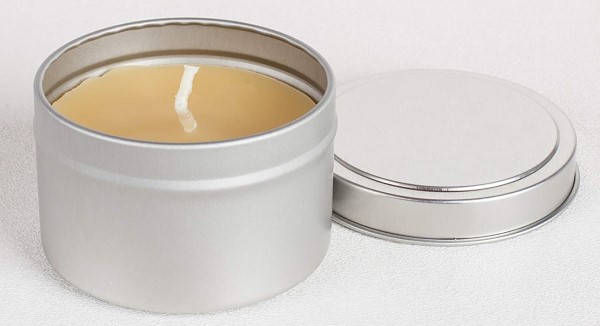
If you’re just trying to cover your basics, which means being able to survive a two-week emergency, you can back out the math. For example: If a candle lasts 25 hours, and you’re only using it to keep a room bright enough for basic needs, you could assume 6 hours of burn time per day (from dusk until sleep) for 4 total days per candle.
So 2 weeks would require about 4 candles. That means you’ll cover the vast majority of emergency situations for $20-40.
But that’s just the bare-bones. You’ll need more for multiple rooms, to create enough heat to warm a shelter or food/water, etc.
Heating and cooking with candles
Many preppers cite heating and cooking with candles. These are possibilities but just aren’t realistic. It’s like digging a latrine with a spoon. Sure, you can do it, but there are much better tools. The HERC ovens can cook food with small tealights, but they’re not cheap.
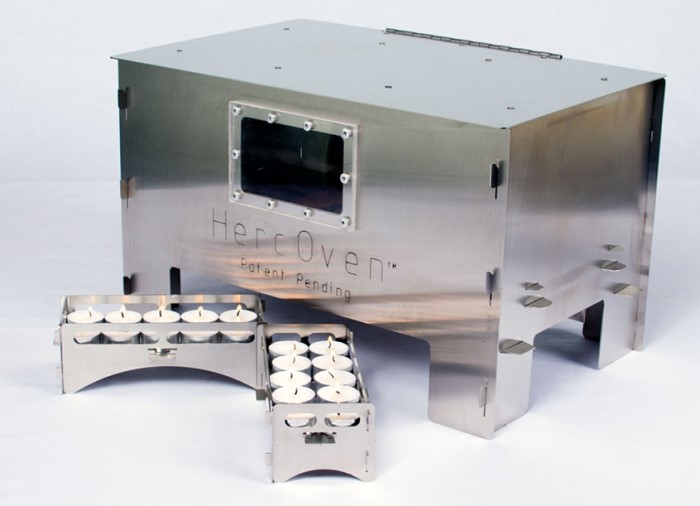
Candles just don’t put out a lot of heat. In The SAS Survival Handbook, John Wiseman states that a candle will raise the temperature inside an igloo by four degrees. That might save your life if you need to raise the temperature in a tent to above freezing, but that’s a last-ditch effort you don’t want to resort to.
There are plans all over the internet for a variety of candle heaters made from clay pots with a metal core or a series of metal cans. It would be handy to know how to make these, but there are better preps to invest in for keeping yourself warm.
More: Best portable space heater
As for cooking, it’s a similar story. In one Instructable, someone built a three-candle burner that can heat a can of soup in 15 minutes or boil water in 45 minutes. Meanwhile, a Jetboil or an inexpensive pocket stove can boil water in about three minutes.
For heating and cooking, you’re better off using your candle to start a larger fire.
Can you make your own?
Yes. There are several ways to do so in a pinch. Here are just a few:
- You can turn an orange into a candle by carefully separating the meat from the rind, filling half with oil, and lighting the pith. It works, but it’s fussy and likely isn’t practical.
- An easier way than the orange is to drop a floating wick in a jar of oil and light it. Kevin’s Kandles sells floating wicks for just this purpose.
- You can easily make your own edible tallow candles by dipping a wick or a length of twine in melted tallow, letting it harden, and then dipping it again. You can even get fancy with it and add herbs and other flavorings.
- Crisco can make a candle. You can either jam a chopstick in the middle to make a hole for a wick or scoop Crisco into a container and insert a wick. Don’t eat the Crisco after using it in a candle.
- Crayons can be melted to make candles.
Safety
Groan. But there’s a real risk here — candles are one of the leading causes of house fires. The National Fire Protection Association offers these eye-opening facts on candles (US data) along with their “CYA” recommendation to avoid using candles indoors altogether:
- From 2014-2018, candles caused over 7,600 house fires
- 21 home candle fires are reported each day on average
- Candles cause 2% of home fires and 6% of home fire injuries
Keep these safety tips in mind:
- If your candles aren’t self-contained, ensure you have a safe flame-proof layer to catch wax drippings. Aluminum foil works in a pinch.
- Do not use candles after an earthquake, which could have broken gas lines, or around any other possible gas source.
- Don’t use candles in a home where oxygen tanks are used.
- Keep candles at least 12 inches away from anything that can burn.
- Use your head: Keep candles out of reach of children and pets, make sure it’s on a solid foundation, don’t leave them unattended (eg. falling asleep), and so on.
- Do you have a fire extinguisher?
Candle types
The most common forms:
- Taper: Long, thin candles that taper at the ends
- Pillar: Thick candles that can stand on their own
- Votive: Short candles intended to sit in a container
- Container: Candles made to always be in a container, such as glass or a metal tin
- Tealight: Small candles housed in a metal or plastic case
Candles that can’t stand alone aren’t the best for preparedness. Opt for pillar candles, tealight candles, or candles that are otherwise housed in a metal tin. The latter is the best choice for a go-bag, since there’s less worry about wax melting and making a mess in your bag.
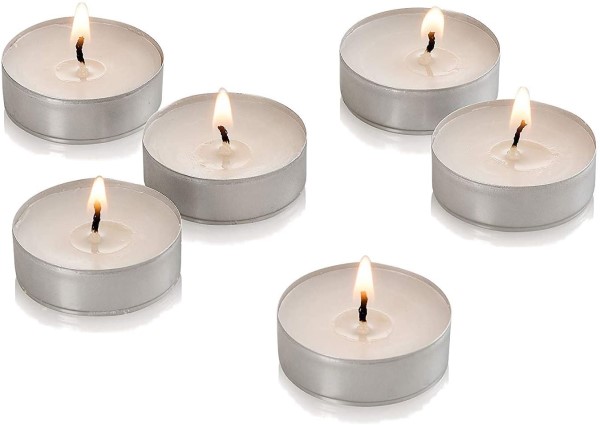
Wick materials
There are a surprising amount of wick types out there. But the reality is that unless you’re making your own candles, you’re not going to get a lot of choices about what wick you get, and the vendor may not even advertise what material they use.
Some candle wicks have lead cores, and although it’s unknown if they pose an actual hazard, most US-based manufacturers abandoned them in the 1970s. If you’re concerned about lead in the wick, buy only candles manufactured in developed countries. To test if a candle wick has lead, run it over a piece of paper. If it leaves a gray pencil-like mark, it probably does.
Common wick types:
- Zinc-cored: These have a metal wire to help the wick stand up during construction and in use.
- Paper-cored: These wicks burn exceptionally hot and aren’t ideal for survival situations.
- Flat braid: These are found in the cheapest candles. They curl while burning to reduce smoke and burn evenly.
- Square braid: These are beefier versions of the flat braided candles, often preferred by beeswax candle makers and survivalists.
- Floating: Wicks simply placed in oil.
But again, this is largely just trivia unless you get into making your own candles.
Wax types
Market realities mean you don’t get a lot of say over wicks, but you have several wax options to choose from:
- Solid paraffin: Paraffin is a byproduct of gasoline production and is the most common type of candle wax. It’s also an inferior wax that gives off irritating fumes and soot, and doesn’t last as long as other types.
- Liquid paraffin: Liquid paraffin candles are a different story, though. They are usually self-contained, don’t give off smoke, and last a very long time.
- Soy: Soy candles are more “natural” than paraffin, and in theory, you can eat them if you’re desperate… but don’t, because soy is often blended with other waxes. Soy is often reported to burn longer than paraffin. Soy is also very soft, so soy candles almost always come in containers.
- Beeswax: Like soy, beeswax is less toxic than paraffin and is often cited as burning longer than paraffin. Melted beeswax is also useful for other things, like rust-proofing steel and treating leather, if you know how to do that.
- Tallow: Many survival manuals recommend tallow candles because of their long life and the fact that they’re edible in an emergency, but they’re almost impossible to buy commercially.
Some candles are infused with citronella, which supposedly helps ward off mosquitos and other insects. But the data shows it’s more myth than fact.
Melt temperatures: You don’t want your candles to melt into a pool of goo while in storage. Different candle waxes have different melt points, generally between 113F (for some soy waxes) to 180F (for palm wax). Soy and paraffin tend to be on the lower end, while beeswax is on the higher end for natural waxes at 144-149F. Different wax blends have different melt points, so check with the candle manufacturer to get the correct temperature.
